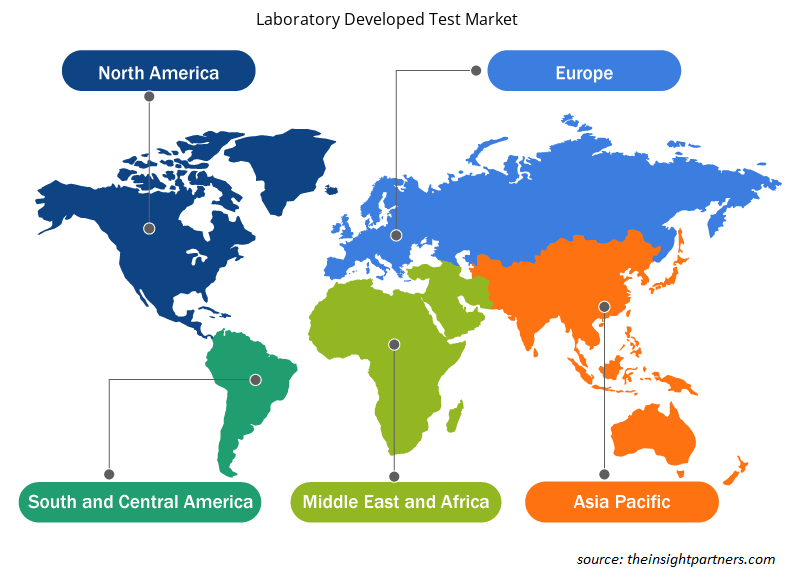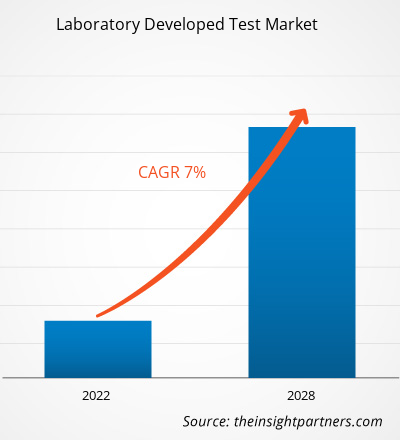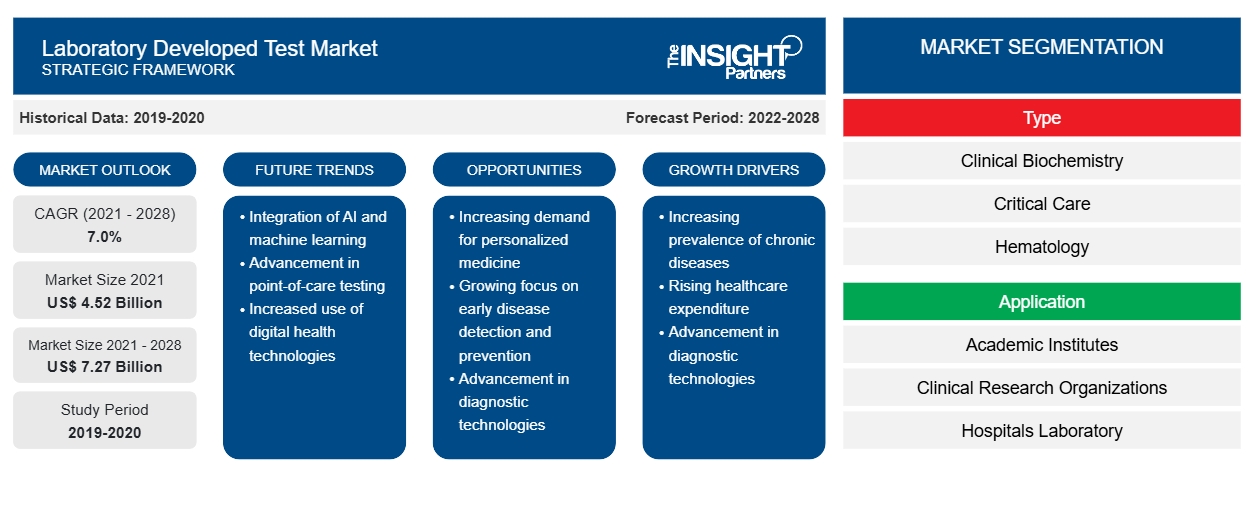Si prevede che il mercato dei test sviluppati in laboratorio raggiungerà i 7.269,3 milioni di dollari entro il 2028, rispetto ai 4.524,75 milioni di dollari del 2021; si prevede che crescerà a un CAGR del 7,0% nel periodo 2021-2028.
Un test sviluppato in laboratorio (LDT) è un tipo di test diagnostico in vitro progettato e utilizzato all'interno di un singolo laboratorio. Questi test possono essere utilizzati per stimare o distinguere analiti quali proteine, biomolecole/composti (glucosio, colesterolo, ecc.) e DNA estratto da campioni raccolti da soggetti umani. L'espansione dei metodi di diagnostica in vitro automatizzata (IVD) per laboratori e dispensari per rendere analisi precise e prive di errori sta alimentando la crescita del mercato dei test sviluppati in laboratorio.
La crescita del mercato dei test sviluppati in laboratorio è attribuita principalmente a fattori quali l'aumento di casi di cancro e disturbi genetici e il gran numero di lanci di prodotti. Tuttavia, il cambiamento del panorama normativo sta ostacolando la crescita del mercato. Ad esempio, in Europa, la conformità al Regolamento sui dispositivi in vitro (IVDR) sarà obbligatoria per tutti i test diagnostici in vitro da maggio 2022; il regolamento mira a garantire l'efficacia clinica e la sicurezza dei test medici, trasformando così il settore diagnostico, il che è una grande preoccupazione per gli operatori del mercato.
Personalizza questo report in base alle tue esigenze
Riceverai la personalizzazione gratuita di qualsiasi report, comprese parti di questo report, o analisi a livello nazionale, pacchetto dati Excel, oltre a usufruire di grandi offerte e sconti per start-up e università
-
Scopri le principali tendenze di mercato in questo rapporto.Questo campione GRATUITO includerà analisi di dati che spaziano dalle tendenze di mercato alle stime e alle previsioni.
Approfondimenti di mercato
La ricerca continua sui medicinali personalizzati offre opportunità di crescita agli operatori del mercato dei test sviluppati in laboratorio
Gli LDT svolgono un ruolo fondamentale nello sviluppo di medicinali personalizzati che probabilmente si riveleranno mezzi promettenti per affrontare le malattie attraverso trattamenti o cure efficaci finora elusi. Secondo la Personalized Medicine Coalition, i medicinali personalizzati rappresentavano solo il 5% delle nuove entità molecolari approvate dalla FDA nel 2005; tuttavia, nel 2016, questo numero è salito a oltre il 25%. Inoltre, il 42% di tutti i composti e il 73% dei composti oncologici in fase di sviluppo hanno il potenziale per fungere da medicinali personalizzati. Le aziende biofarmaceutiche hanno quasi raddoppiato i loro investimenti in R&S in farmaci personalizzati negli ultimi cinque anni e si prevede che aumenteranno ulteriormente i loro investimenti del 33% nei prossimi cinque anni. I ricercatori biofarmaceutici prevedono anche un aumento del 69% nello sviluppo di medicinali personalizzati nei prossimi cinque anni. I test di laboratorio vengono utilizzati per diagnosticare le malattie e prevedere e monitorare la risposta ai farmaci, nonché per ottenere dati informatici necessari per algoritmi predittivi complessi. play a vital role in the development of personalized medicines that are likely to prove as promising means of tackling diseases through far eluded effective treatments or cures. As per the Personalized Medicine Coalition, personalized medicines accounted for only 5% of the new FDA-approved molecular entities in 2005; however, in 2016, this number rose to more than 25%. Additionally, 42% of all compounds and 73% of oncology compounds in the pipeline have the potential to serve as personalized medicines. Biopharmaceutical companies have nearly doubled their R&D investments in personalized drugs in the last five years, and they are further expected to increase their investments by 33% in the next five years. Biopharmaceutical researchers also predict a 69% increase in the development of personalized medicines in the next five years. Laboratory tests are used to diagnose illness and predict and monitor drug response as well as to obtain informatics data needed for complex predictive algorithms.
I farmaci personalizzati stanno diventando il marchio di fabbrica del trattamento del cancro; si tratta di un approccio in continua evoluzione che si basa sulla personalizzazione dei trattamenti in base al patrimonio genetico individuale. Nel 2019, la FDA ha approvato 12 farmaci personalizzati per indagare e affrontare le cause profonde della malattia, combinando così la medicina di precisione nell'assistenza clinica. La crescente domanda di medicina personalizzata offre significative opportunità di crescita per la crescita degli operatori che operano nel mercato dei test sviluppati in laboratorio.
Informazioni basate sul tipo
Il mercato dei test sviluppati in laboratorio, per tipo, è segmentato in biochimica clinica, terapia intensiva, ematologia, microbiologia, diagnostica molecolare, immunologia e altri. Si prevede che il segmento della diagnostica molecolare detenga la quota maggiore del mercato nel 2021. Tuttavia, si prevede che il segmento dell'ematologia registri il CAGR più elevato nel mercato durante il periodo di previsione.CAGR in the market during the forecast period.
Approfondimenti basati sulle applicazioni
Per applicazione, il laboratorio ha sviluppato applicazioni di mercato di prova in istituti accademici, organizzazioni di ricerca clinica, laboratori ospedalieri, centri diagnostici specialistici e altri. Si stima che il segmento dei laboratori ospedalieri rappresenti la quota di mercato maggiore nel 2021. Tuttavia, si prevede che il segmento dei centri diagnostici specialistici registrerà il CAGR più elevato nel mercato durante il periodo di previsione.CAGR in the market during the forecast period.
I lanci e le approvazioni di prodotti sono strategie comunemente adottate dalle aziende per espandere la loro presenza globale e i loro portafogli di prodotti. Inoltre, i test di mercato sviluppati in laboratorio si concentrano sulla strategia di partnership per ampliare la loro clientela, il che, a sua volta, consente loro di mantenere il loro marchio a livello globale.
Il rapporto suddivide il mercato dei test sviluppati in laboratorio come segue
In base al tipo, il mercato dei test sviluppati in laboratorio è segmentato in biochimica clinica, terapia intensiva, ematologia, microbiologia, diagnostica molecolare, immunologia e altri. In base all'applicazione, il mercato dei test sviluppati in laboratorio è segmentato in istituti accademici, organizzazioni di ricerca clinica, laboratori ospedalieri, centri diagnostici specialistici e altri. In base alla geografia, il mercato dei test sviluppati in laboratorio è segmentato in Nord America (Stati Uniti, Canada e Messico), Europa (Regno Unito, Germania, Francia, Italia, Spagna e resto d'Europa), Asia Pacifico (Cina, Giappone, India, Australia, Corea del Sud e resto dell'Asia Pacifico), Medio Oriente e Africa (EAU, Arabia Saudita, Sud Africa e resto del Medio Oriente e Africa) e America meridionale e centrale (Brasile, Argentina e resto dell'America meridionale e centrale).
Approfondimenti regionali sul mercato dei test sviluppati in laboratorio
Le tendenze regionali e i fattori che influenzano il Laboratory Developed Test Market durante il periodo di previsione sono stati ampiamente spiegati dagli analisti di Insight Partners. Questa sezione discute anche i segmenti e la geografia del Laboratory Developed Test Market in Nord America, Europa, Asia Pacifico, Medio Oriente e Africa e Sud e Centro America.

- Ottieni i dati specifici regionali per il mercato dei test sviluppati in laboratorio
Ambito del rapporto di mercato sui test sviluppati in laboratorio
| Attributo del report | Dettagli |
|---|---|
| Dimensioni del mercato nel 2021 | 4,52 miliardi di dollari USA |
| Dimensioni del mercato entro il 2028 | 7,27 miliardi di dollari USA |
| CAGR globale (2021 - 2028) | 7,0% |
| Dati storici | 2019-2020 |
| Periodo di previsione | 2022-2028 |
| Segmenti coperti |
Per tipo
|
| Regioni e Paesi coperti |
America del Nord
|
| Leader di mercato e profili aziendali chiave |
|
Test di laboratorio sviluppato Mercato di attori Densità: comprendere il suo impatto sulle dinamiche aziendali
Il mercato dei test sviluppati in laboratorio sta crescendo rapidamente, spinto dalla crescente domanda degli utenti finali dovuta a fattori quali l'evoluzione delle preferenze dei consumatori, i progressi tecnologici e una maggiore consapevolezza dei vantaggi del prodotto. Con l'aumento della domanda, le aziende stanno ampliando le loro offerte, innovando per soddisfare le esigenze dei consumatori e capitalizzando sulle tendenze emergenti, il che alimenta ulteriormente la crescita del mercato.
La densità degli operatori di mercato si riferisce alla distribuzione di aziende o società che operano in un particolare mercato o settore. Indica quanti concorrenti (operatori di mercato) sono presenti in un dato spazio di mercato in relazione alle sue dimensioni o al valore di mercato totale.
Le principali aziende che operano nel mercato dei test sviluppati in laboratorio sono:
- Diagnostica di ricerca incorporata
- F. HOFFMANN-LA ROCHE LTD.,
- QIAGEN
- Illumina, Inc.,
- Eurofins Scientific
Disclaimer : le aziende elencate sopra non sono classificate secondo un ordine particolare.

- Ottieni la panoramica dei principali attori del mercato dei test sviluppati in laboratorio
Profili aziendali
- Diagnostica di ricerca incorporata
- F. HOFFMANN-LA ROCHE LTD.,
- QIAGEN
- Illumina, Inc.,
- Eurofins Scientific
- Biodesix
- Biotecnologie adattive
- Bioteranostica
- Rosetta Genomics Ltd.,
- Salute Guardante
- Analisi storica (2 anni), anno base, previsione (7 anni) con CAGR
- Analisi PEST e SWOT
- Valore/volume delle dimensioni del mercato - Globale, Regionale, Nazionale
- Industria e panorama competitivo
- Set di dati Excel
Report recenti
Testimonianze
Motivo dell'acquisto
- Processo decisionale informato
- Comprensione delle dinamiche di mercato
- Analisi competitiva
- Analisi dei clienti
- Previsioni di mercato
- Mitigazione del rischio
- Pianificazione strategica
- Giustificazione degli investimenti
- Identificazione dei mercati emergenti
- Miglioramento delle strategie di marketing
- Aumento dell'efficienza operativa
- Allineamento alle tendenze normative























 Ottieni un campione gratuito per - Mercato dei test sviluppati in laboratorio
Ottieni un campione gratuito per - Mercato dei test sviluppati in laboratorio